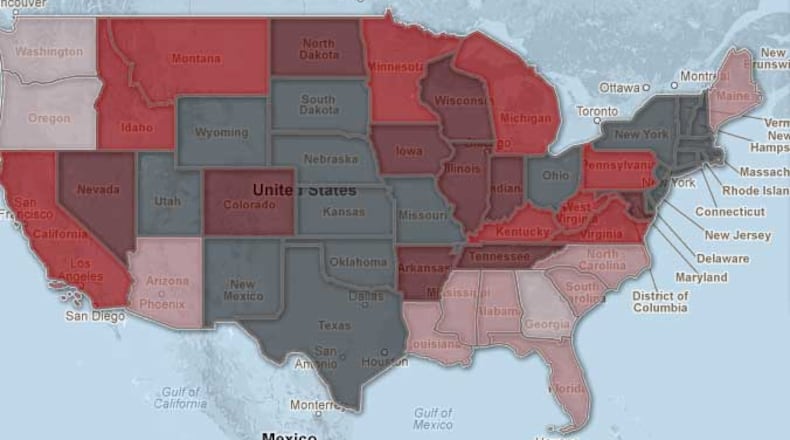Miami Valley Weather Records Set in 2012
Temperatures at airports:
- Cincinnati at Lunken Airport, 86 degrees on March 21
- Cincinnati at Lunken Airport, 103 degrees on June 28
Temperatures by county:
- Hamilton County, 86 degrees on March 21
- Montgomery County, 83 degrees on March 20
- Montgomery County, 86 degrees on March 21
Rain
- Champaign County at St. Paris, 2.9 inches on 5/5/2012
Snowfall
- Champaign County at St. Paris, 7.2 inches on 12/27/2012
- Darke County at Greenville, 11 inches on 12/27/2012
Source: Natural Resources Defense Council
An interactive national map of temperature records and chart of Ohio and national temperature changes since 1950 available at DaytonDailyNews.com.
Extreme weather slammed the area, state and nation last year with more than 3,500 records set, a report released Tuesday said.
It was the hottest year on record in the lower 48 states and the Miami Valley and Ohio also hit records, according to the report by the Natural Resources Defense Council, an environmental advocacy group.
The year included wild weather like Hurricane Sandy and the summer’s super derecho storm that swept across hundreds of miles and cut power to tens of thousands of Ohioans.
The weather last year set roughly 300 more records than the 3,251 records set in 2011, with record-breaking heat, rainfall and snow, the council said. The group used data from the National Climatic Data Center, managed by the National Oceanic and Atmospheric Administration, the construct the report.
It’s the third report since the beginning of the year to highlight extreme weather and climate change, and the only one so far to include county-by-county breakdowns. The State of the Climate report was released by NOAA earlier this year as was the draft National Climate Assessment, a multi-federal agency study.
Collectively, the reports could fire up renewed debate about climate change.
The council listed the top national weather record-breaking events as:
- Hurricane Sandy's storm surge height at 13.88 feet, which broke the all-time record in New York Harbor, and ravaged communities across New Jersey and New York with flood waters and winds.
- The summer of 2012's drought, the worst in 50 years across the nation's breadbasket, with more than 1,300 U.S. counties in 29 states declared drought disaster areas.
- The hottest March on record in the contiguous U.S., with July the hottest single month ever recorded in the lower 48 states.
- Wildfires that burned more than 9.2 million acres in the U.S., and destroyed hundreds of homes.
In 2012, Ohio’s weather tally looked like this:
- Record-breaking heat in 26 counties with a total of 55 new heat records.
- Record-breaking rainfall in nine counties with a total of 10 new rainfall records.
- Record-breaking snow in nine counties with a total of 10 new snow records.
- One large wildfire.
WHIO-TV meteorologist Erica Collura said that based on National Weather Service records, 2012 for Dayton ranked as the city’s fourth warmest year on record with an average temperature of 55.3 degrees. Yearly averages are usually around 52 degrees, Collura said. Records go back to 1896.
For Columbus, 2012 was the warmest year on record. Cincinnati in 2012 tied for its fifth warmest year on record since records began there in 1873, Collura said.
Citing findings from international insurance giant MunichRe, the council said that from 1980 through 2011, the frequency of weather-related extreme events in North America nearly quintupled, rising more rapidly than anywhere else in the world.
The council said the record-breaking is another indication of man-made climate change at work, moving at a pace that strains efforts at recovery.
“2012’s unparalleled record-setting heat demonstrates what climate change looks like,” said Kim Knowlton, senior scientist for the council. “This extreme weather has awoken communities across the country to the need for preparedness and protection. We know how to reduce local risks, improve our lives and create more resilient communities. Now our leaders must act.”
But others say there is little evidence the Earth’s climate is becoming more severe.
“When Hurricane Sandy devastated New York City last year, it was only a Category 1 storm in terms of wind speed. No strong hurricane (Category 3 winds or stronger) has made landfall in the U.S. during the last seven years, the longest such period on record,” said Steve Goreham, executive director of the Climate Science Coalition of America, in a column that appeared in Tuesday’s Washington Times. “The count of strong to violent U.S. tornadoes has been flat to declining over the last 30 years. Even a chart (in one of the recently released goverment reports) shows that U.S. droughts were most severe during the 1930s and 1950s.”
About the Author
